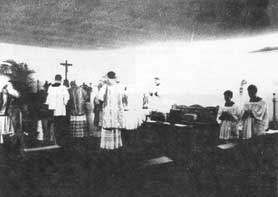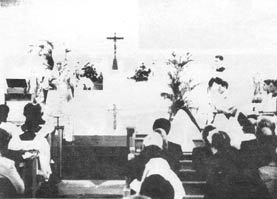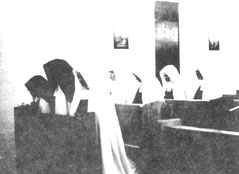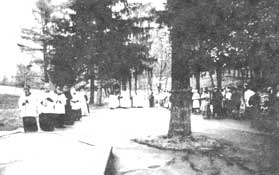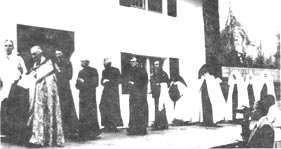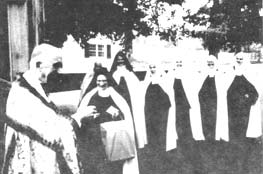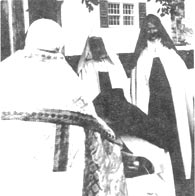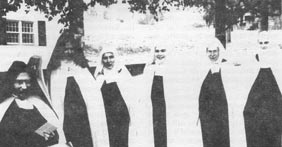The Six Carmelites and Archbishop Lefebvre

|
On November 13, 1985, His Grace Archbishop Marcel Lefebvre blessed the Carmel of the Most Holy Trinity in Phoenixville, Pennsylvania. The text which follows is the sermon of Archbishop Lefebvre during the Solemn High Mass which preceded the blessing.
|
A family photo, after Holy Mass: Mother Marie-Christiane, Foundress of five traditional Carmelite Convents; Mother Mary Mechtilde, Mother Superior of the Carmel of the Most Holy Trinity; Archbishop Lefebvre (Mother Marie-Christiane's brother); Sister Mary Lucy, from Montreal: Sister Stella Mary, from San Antonio, Texas; Sister Mary of the Passion, from Australia, and Sister Mary Joseph, from Manitoba, Canada.
In the name of the Father and of the Son and of the Holy Ghost. Amen.
My dear Sisters, my dear brethren.
Now you can see that there really is a Catholic Carmel in America! It is a fact! It is the effect of the many prayers of you, my dear brethren, and it is also the effect of the good Christian families that we still have in America, because some of the children come to the Sisters of the convent of Carmel. And it is also the effect of the fruit of the prayers of the Sisters and all Carmelites, and their resolution to come here to America. We thank God today for this foundation and thank also our dear Blessed Virgin Mary, the true Mother of the Carmelites. We thank also all those people who pray for this convent here in Phoenixville.
What is a Carmel, my dear brethren? A Carmel is a house of prayer. What is prayer? Prayer, says the catechism, is the elevation of our soul to God. It is also the realization of our life here in this heart. Why did God create the spirit? Why did God give us a soul? To know, to love and to serve God. and in this way, to obtain the glorification of our souls. That is the first reason for the foundation of the Carmelite convent: To know God. to love God and to serve God, by Jesus Christ, in Jesus Christ, because after the Incarnation we know that it is impossible to really pray with good fruits without Jesus Christ. And so the Sisters in this convent give us the magnificent example of prayer. It is impossible to think of a Carmelite Sister without knowing that their life is a life of prayer. That is very necessary in our time of confusion in the Church, a time when many convents are closed. It is very, very necessary that these Sisters pray for us, pray for your families. Many blessings comes from the prayers of the Sisters in America. We must thank God.
What is a Carmel? A Carmel is a house of sacrifice. We cannot love God without sacrifice. Jesus Christ Himself gave us the way to love God, by His sacrifice on Calvary, His sacrifice on the Cross. That is the most important thing in His life: His sacrifice on the Cross. It is the witness of the love of Jesus Christ for His disciples. Here He gave His life for the glory of His Father; and He said that we must bring our cross and follow Him if we truly want to become His followers. So also we must take the good example of these Carmelite Sisters, to make sacrifices in our own life, if we truly want to obtain a crown in heaven. All the saints give us this magnificent example of sacrifice. We know that, because of the consequence of original sin, we are too occupied by worries, and we even forget the spiritual life; we forget to pray; we know that. And so it is very important to make sacrifices, to abandon anything in this life to love God, to be united with God; this is very important. We thank these good Sisters for giving us a good example of sacrifice.
What is a Carmel? A Carmel is a missionary convent, a missionary house. But what mission do the Sisters have? They pray, and they give the sacrifice of their lives to save souls. To save their own souls, but also to save our souls. You know that Pope Pius named the little Teresa of the Child Jesus as Protector of All Missions. Why? This little Sister, in her Carmel, lived a very short time—I think twenty-four, twenty-five years. She died and Pope Pius named her Patroness of All Missions. We know that after she died, many, many people everywhere in the world received many blessings by the prayer of this little Sister of the Child Jesus. And so she was a very great missionary. That is also the task of the Carmelite Convent, to be missionary.
And pray for the priests! You know that now, in this crisis of the Church, the crisis is more in the clergy than in the laity. Recently the newspapers said that in Italy, near Castelgandolfo, former priests who got married were meeting. They say themselves, there were seventy thousand. Seventy thousand! One for every five priests in the world . . . abandoned his duty of the priesthood to get married. That is a sign of our time, this time of the destruction of the Church. And so it is very important to have good and holy priests, true Catholic priests.
That is also a great intention of the prayers of the Carmelite Sisters. We hope that by this presence of the Sisters in America many young girls shall receive vocations to become religious sisters and that many young men will become seminarians and priests. So we know truly that the Catholic Church is helped by the Carmelite Convent and it is also a help to the Society of St. Pius X, to good priests, holy priests, Catholic priests, to continue the Catholic Church and not abandon the Catholic priesthood.
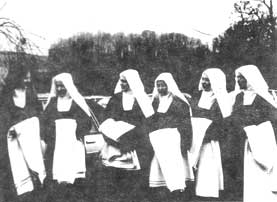
The present temporary chapel of the Carmel is much too small to hold the faithful who came for this occasion—and indeed there were many, even though it was in the middle of the week and notice was short. The Solemn High Mass was celebrated at St. John Newman's Chapel, which is just up the hill from the Carmel. Here, the Sisters arrive for Mass. This was an exceptional circumstance for the faithful to see the Carmelites. Their cloistered life is so strict they can normally only be seen through a black veil and a heavy grill . . . Here you can see, left to right, the young Mother Superior, Mother Mary Mechtilde, with her novices: Sister Mary Lucy, Sister Stella Mary, Sister Mary of the Passion, Sister Mary Hilda and Sister Mary Joseph. The professed nuns have a black veil and the novices a white veil.
And now, during this Catholic Mass, we shall pray to God and to Our Lord Jesus Christ, to give many blessings to the Sisters, by the intercession of the Blessed Virgin Mary, that they continue the good tradition of the Carmelite Sisters of centuries and centuries. They are good Carmelite Sisters and we can be sure that they remain the children of St. Teresa, the Foundress, who renewed the life of the Carmelite Sisters.
We hope, by the blessing of God, that through this convent in America, all people in America will receive many blessings.
In the name of the Father, and of the Son and of the Holy Ghost. Amen.
The Solemn High Mass in St. John Newman's Chapel. Father Urban Snyder of Boston, Kentucky was deacon. Father Laisney was subdeacon. Seminarians were servers and sang the Mass. Father Snyder, former Master of Retreats at Gethsemane, the Trappist Monastery in Kentucky where Thomas Merton was, will be coming every so often to the Carmelite Convent to be the extraordinary confessor to the nuns and to give them spiritual conferences.
Archbishop Lefebvre during his sermon. The nuns were in the first pews on the right. The seminarians from St. Thomas Aquinas Seminary in Ridgefield, Connecticut, were in the first pews on the left.
The Sisters' Thanksgiving following Holy Mass.
The nuns did not stay long at the chapel up the hill! As soon as the ceremony was concluded, they went downhill to their convent. The procession was thus formed: Cross-bearer, two acolytes with candles, the seminarians, the Bishop, the priests, the nuns and then the faithful. The Bishop first blessed the grounds, then the house. He alone went into the house.
The Bishop and priests in front of the house, left to right: Father Richard Williamson, Rector of St. Thomas Aquinas Seminary; Archbishop Lefebvre; Father Laisney; Father Snyder; Father Gregory Foley, chaplain of the nuns and Pastor of St. John Newman Mission; Father Edward Black, Superior of England, who accompanies His Grace on his two-month journey to America and Australia; Father Ronald Ringrose, Pastor of St. Athanasius, Vienna, Va.; then the two Mothers Superior, followed by the Sisters.
After the blessing of the Carmel, Archbishop Lefebvre hands over the key to the Mother Superior who will close the door. The faithful had said a few words of encouragement to the nuns, and asked for prayers for their many intentions! They had also been generous and Mother Marie-Christiane had a bag full of the gifts of the faithful!
Mother Marie-Christiane kissed the Bishop's ring and the key of the Carmel.
The last view the faithful had of the Nuns before the doors were closed. The parents of a nun were there and had an occasion to kiss her, maybe for the last time! The only ones who will again see these nuns are those young girls who long for Him in a life of total consecration to Our Divine Savior, Jesus Christ.
